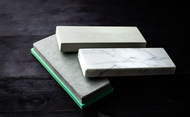Sharpening Stones: A High-Level Guide
8th Sep 2025
Here for information on tool and knife sharpening stones? You’re in the right place. This short guide will break down some of the details. See if you can find what you need here, then get in touch with us if you still have questions.
Sharpening Stone Grits
Regardless of whether the sharpening stone is made from a natural or synthetic material, the level of the grit is inverse to the fineness of the stone. That is, a very high grit will leave a very fine edge, and a low grit will leave a coarse edge. Here are some relatively helpful ratings.
- 150 grit and lower: These are the coarsest stones available and are used for aggressive edge stock removal and edge re-profiling. They are so coarse they will leave visible striations in the edge.
- 150 to 220 grit: Not as coarse as 150 grit but still very coarse and can be used for fast metal removal.
- 220 to 400 grit: Slightly finer, still used for aggressive sharpening, will leave some visible striations on the edge.
- 400 to 600 grit: Finer, offers a slower sharpening rate, the edge of the knife will look frosted or clouded after using a sharpening stone of this grit.
- 600 to 1000 grit: Between 600 and 1000 grit will leave a finer edge; at 1000 grit, an edge that is nearly razor sharp can be left on the blade.
- 1000 to 3000 grit: A stone between 1000 and 3000 grit will leave a very fine, polished, razor sharp edge.
- 3000 grit and up: Stones 3000 grit and finer can be used on chisels, straight razors and other similar instruments. They leave the finest, sharpest edges with a mirror finish.
Sharpening Stone Materials
Sharpening stones are made with either natural or synthetic materials, the most common of which will be covered here.
- Arkansas stone (novaculite): Arkansas stone, or novaculite, is likely the most common natural material from which sharpening stones are made. From coarsest to finest, the grades are soft, hard, translucent and hard black Arkansas stone.
- Coticule: Coticule, often marketed as Belgian blue coticule, is a natural stone that is often used for honing straight razors.
- Aluminum oxide: Aluminum oxide is a common synthetic compound used in the manufacture of sharpening stones. Most are coarser, but there are finer aluminum oxide synthetic stones available.

- Ceramic sharpening stones: Ceramic sharpening stones are synthetic and as such can be manufactured to just about any grit.
- Glass sharpening stones: Like ceramic stones, glass sharpening stones can be manufactured to any grit desired.
- Diamond knife sharpeners: Diamond knife sharpeners, also known as diamond stones, consist of a synthetic medium into which diamond dust is impregnated. They can be either coarse or fine according to the grade of the dust.
Different Types of Knife Sharpeners
In addition, there are many different types of knife sharpening stones and other knife sharpening kits. Here are some of the main ones.
- Bench stones: Bench stones are larger sharpening stones, usually 4 to 8 inches if not bigger. They are intended to be used as stationary sharpening tools.
- Pocket stones (pocket knife sharpeners): Pocket knife sharpeners are on the smaller side, usually between 2 and 3 inches, and are intended to be portable so you can sharpen knives away from home.
- Sharpening rods: Sharpening rods are cylindrical knife sharpeners. While they can easily be used to sharpen a straight or swept edge, they can also be used to sharpen inwardly curved knife profiles like talon blades and hawkbills. If narrow enough, they can also be used to sharpen kitchen knives and pocket knives with serrated blades.
- Pull-through knife sharpeners: Pull-through sharpeners are much simpler than stones; to use one you simply draw the knife through it. Because of this, the angle of the edge cannot be adjusted.
- Knife sharpening kits: Knife sharpening kits are systems that usually come with multiple stones, rods, and guides, which simplify the process of sharpening. Some types of sharpening systems have edge angle guides and electric sharpeners.
Sharpening Stone Maintenance
Keep your sharpening stone clean, and wipe off debris after using. You can also use water, oil or a honing solution when in use to help float away small particles of metal swarf.
Synthetic stones will also need to be flattened from time to time, for which a flattening stone will be required. Use the entire surface of the stone to help prevent the stone from becoming washed or dished out.
Do not stack your stones in storage; store them individually, and in a cool, dry location. Make sure to dry them thoroughly before storing if you use water or a honing solution on them.

Shop Knife Sharpening Stones Here
Here for a new knife sharpening kit, or just a pocket knife sharpener? Shop our full collection of sharpening stones, which includes bench stones as well as pocket stones, along with diamond knife sharpeners, via the links in this article.
If you can’t find what you’re looking for or you have additional questions that were not answered by this article, feel free to get in touch with us.









